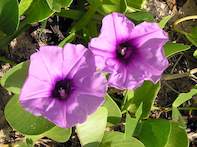
Name
Goat's foot or morning glory (Ipomoea pes-caprae subsp. Brasiliensis)Description
Named after its lobed leathery leaves that looks like a goat’s hoof, the goat's foot is a sprawling creeper with long trailing stems growing a few meters long. The bright purple flowers looks like trumpets. A similar species is Canavalia rosea is found from northern kwaZulu-Natal to Mozambique. This creeping plant also prefers dunes but has trilobed leaves. Its small purple flowers look similar to that of a pea.
Habitat
A hardy creeper, the goats foot is drought tolerant and has a deep root system that can help to stabilise sandy soils. It is commonly found on tropical and subtropical beaches and dunes of the Pacific, Indian and Atlantic Oceans. It is extremely salt resistant and can survive in salt water.Field Notes
The goat’s foot is often found on dunes as its floating and salt water tolerant seeds are dispersed by the ocean making it a good example of oceanic dispersal.Considered a valuable medicinal plant worldwide, a tea made from the leaves are used to treat colds and flu while the seeds are used against some venereal diseases.